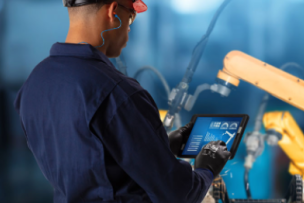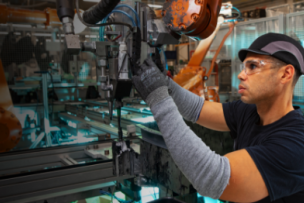Honeywell’s safety innovations protect the livelihoods of 500 million workers. With a legacy spanning over a century, Honeywell provides comprehensive PPE solutions from head-to-toe. Honeywell offers a vast of product solutions from brands you trust like Miller®, Uvex®, Howard Leight, North®, and Fibre-Metal®.
Today, there are nearly 873,000 workers in the automotive manufacturing industry in the United States alone. Compared with other industries, automotive manufacturing has more than double the rate of non-fatal injuries (6.3 injuries and illnesses per 100 full-time workers in 2018 compared to 2.8 for all other private industries). Given these numbers, safety should always be the top priority.
A working environment with both robots and people
As the automotive industry evolves, repetitive tasks that require precision are being performed by advanced technologies. These technologies are being integrated at every stage of vehicle manufacturing; some tasks once performed by people are now being performed through robotics. There are many benefits to integrating robotics, such as increased productivity in performing complex tasks and reduced waste resulting from increased precision. However, arguably the best benefit of integrating robotics is that it has helped “engineer out” hazards, which helps keep the workplace safer.
While robotics is being integrated more and more frequently in the automotive industry, there are still many tasks that require people, such as painting, stamping, machining and assembling. These functions performed by automotive workers, typically at the same plant, still come with hazards. Hand injuries—like cuts, lacerations and punctures—are the third-most common type of injury in manufacturing, with more than 23,000 non-fatal injuries occurring in 2020.
The top hand hazards in automotive manufacturing and how to select appropriate protection
In the automotive manufacturing industry, the top five cut risks can be found in:
- Stamping Presses
- Cutting Raw Materials
- Assembling
- Fitting Windshields
- Logistic Operations
Each task may have a different hazard and require different types of protection. So how does Site Safety ensure the correct PPE is being used when there are all these different hazards? A good first step is a Hand Hazard Assessment, where a site’s various tasks and risks can be individually evaluated.
For example, when selecting gloves, the job hazard must always be identified. Stamping presses may require a cut level A3, and the glove may need to be silicone-free because workers handle unpainted products. In assembly, workers may require an A3 cut with impact protection because of cut and crush hazards, yet they may not require silicone-free gloves since the painting process is complete. It is important to evaluate processes on an individual basis as hazards vary so the protective measures may vary as well.
How to keep people in gloves?
Innovation in the automotive industry doesn’t just include robotics; manufacturers of PPE are innovating too. Honeywell knows that workers like to wear gloves that are comfortable and ergonomic. They are constantly evaluating their glove line because they know that uncomfortable or ill-fitting gloves mean employees are at risk of taking them off or not wearing them entirely.
Innovations in materials, like the Honeywell Moisture Dispersion Technology in their Chemical Glove, Flextril™, help keep hands dry through sweat management techniques, or their Super Grip Technology, which helps reduce the effort needed to hold and handle tools and minimizes hand fatigue.
It Is important to note that PPE selection should always be an on-going process as new innovations continue to emerge; this helps employers keep their workers both comfortable on the job and safe from the different hazards they encounter.
Keeping workers safe by keeping them comfortable
Honeywell has a long-standing commitment to worker safety; they not only offer a wide range of safety gloves, from cut- to chemical-resistant gloves, but they also offer hand hazard assessments to ensure the proper protective-yet-comfortable glove is selected. To learn more about the products and services they offer, visit their website.
Previously Featured on Honeywell's blog.








Talk to Us!
Leave a reply
Your email address will not be published. Required fields are marked *